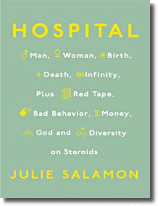
About the book, from the Penguin Press catalogue, Summer 2008:
The hospital in Borough Park did not fit Gregorius’s blithe vision of work hard, play hard. His memories of his first foray into the Maimonides emergency room were vague: Crowded. Really crowded. Stretchers with patients were lined up two-and three-deep, with the lucky ones semi-secluded behind curtains that barely closed. He noticed that the melting-pot-mayhem--Hasids, Chinese, Pakistanis, Haitians, Russians, Bulgarians—did not seem to include anybody like him, a tall, skinny, white surfer-ski-boy from the Midwest. The visual overload was matched by the audio: Tower of Babel at top volume, accompanied by the constant beeping of monitors, pagers, telephones. The usual E.R. smells of antiseptic and bodily stink, but also strange spicy odors he couldn’t place.Among the early acclaim for Hospital:
Had he landed in the Third World, or a developing nation, whatever the correct terminology of the moment was? Before he could panic, he came across evidence that he was, indeed, firmly situated in the First World, 21st century: Maimonides had HealthmaticsED, a very cool, very tomorrow, computer system that, among other things, allowed doctors and nurses to track on a patient in real time. The computer monitors were stationed like beacons of sanity throughout the room. For Gregorius, they made the chaos seem almost comprehensible.
Overcrowding had become commonplace in American emergency rooms which had, for people without medical insurance, become the doctor’s office. In June, 2006, almost a year after Gregorius began his residency, the Institute of Medicine of the National Academies would publish a report that warned: “A national crisis in emergency care has been brewing and is now beginning to come into full view.” The emergency department at Maimonides, which would process more than 84,000 patients in Gregorius’s first year, was not the busiest E.R. in the country or in New York City. But it was arguably the most intense.
Maimonides—make that Brooklyn, early 21st century—was an epicenter of the cultural forces that had been rocking and roiling the American experiment for a generation. The hospital, by necessity and tradition, remained a DMZ zone, where patients dragged in not just their wounds, fevers and malfunctions, but their accents and customs, their immigration and insurance problems, their feelings about being outsiders. Hope and heart-ache in 67 languages. Sick and scared, they yearned for kindness and prayed for competence from the doctors, nurses, floor cleaners, lab technicians, paper pushers and social workers, who had their own troubles, and were often newcomers themselves. At Maimonides, cross-cultural forces made for one big surf tide.
“I've never had much interest in hospitals (or been able to sit through an episode of "ER"), but as Salamon expertly sucked me into the saga of Maimonides, I realized this was about more than white coats, scalpels and beeping consoles. This place was 21st century America in a microcosm.”Learn more about the book and author at Julie Salamon's website.
—Laura Miller, Salon
“The fine grain of Ms. Salamon's observations allows her to paint a compelling—and damning—portrait of a dysfunctional health-care system… Its careful documentation of financial crises, feuds, personality clashes and, most of all, life-and-death drama it feeds the same appetite for pathos, intrigue, tragedy and redemption…as the current plethora of medical programs.”
—Economist
“[A] remarkable portrait ... Salamon succeeds in providing a completely unique, three-dimensional and compellingly human perspective of the demanding work — both frustrating and rewarding that is not always apparent to hospital patients and their families.”
—Publishers Weekly (starred review)
“Reading HOSPITAL feels a little like watching one of those speeding-gurney sequences on ER — fast pasted, high stakes, and crowded with colorful characters all shouting at once. The difference is that Julie Salamon's book is more informative, more nuanced, and closer to reality.... Ultimately, HOSPITAL is immensely heartening. If there is hope for our overburdened healthcare system, Salamon's book suggests, we can thank the decent, thoughtful men and women laboring overtime to improve the quality of life — and death — in our gloriously lumpy American melting pot.”
—Francine Prose, O Magazine
“There's "ER," there's "Grey's Anatomy," and then there's this real, true-life drama of the barely controllable chaos that actually rules in a huge metropolitan hospital, by one of America's best fly-on-the-wall reporters, Julie Salamon.”
—Tom Wolfe, author of I Am Charlotte Simmons
“It would seem a fine time to burrow into the inner workings of an American hospital, which is what Julie Salamon has done...a solid piece of reportage. In the end, you come to admire the book's principal figures, as Ms. Salamon does, however flawed they might be. The physicians and administrators, she makes clear, 'tried to remember--against the odds posed by a greedy and corrupted health-care system and by institutional and human frailty--that healing was the heart of the matter.”
—Wall Street Journal
Julie Salamon, author of seven books, including The Devil's Candy and Rambam's Ladder, was a reporter and critic for the New York Times and the Wall Street Journal.
The Page 99 Test: Hospital.
--Marshal Zeringue





